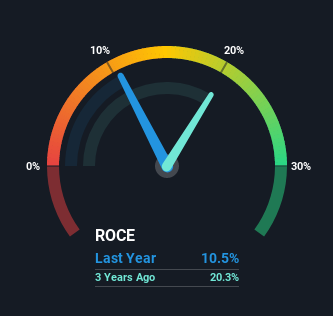- Hong Kong
- /
- Medical Equipment
- /
- SEHK:1763
Capital Allocation Trends At China Isotope & Radiation (HKG:1763) Aren't Ideal

Finding a business that has the potential to grow substantially is not easy, but it is possible if we look at a few key financial metrics. Firstly, we'll want to see a proven return on capital employed (ROCE) that is increasing, and secondly, an expanding base of capital employed. Ultimately, this demonstrates that it's a business that is reinvesting profits at increasing rates of return. Having said that, from a first glance at China Isotope & Radiation (HKG:1763) we aren't jumping out of our chairs at how returns are trending, but let's have a deeper look.
What is Return On Capital Employed (ROCE)?
Just to clarify if you're unsure, ROCE is a metric for evaluating how much pre-tax income (in percentage terms) a company earns on the capital invested in its business. To calculate this metric for China Isotope & Radiation, this is the formula:
Return on Capital Employed = Earnings Before Interest and Tax (EBIT) ÷ (Total Assets - Current Liabilities)
0.10 = CN¥692m ÷ (CN¥9.6b - CN¥3.0b) (Based on the trailing twelve months to June 2021).
So, China Isotope & Radiation has an ROCE of 10%. That's a pretty standard return and it's in line with the industry average of 10%.
Check out our latest analysis for China Isotope & Radiation

In the above chart we have measured China Isotope & Radiation's prior ROCE against its prior performance, but the future is arguably more important. If you'd like to see what analysts are forecasting going forward, you should check out our free report for China Isotope & Radiation.
What Can We Tell From China Isotope & Radiation's ROCE Trend?
When we looked at the ROCE trend at China Isotope & Radiation, we didn't gain much confidence. Over the last five years, returns on capital have decreased to 10% from 29% five years ago. Although, given both revenue and the amount of assets employed in the business have increased, it could suggest the company is investing in growth, and the extra capital has led to a short-term reduction in ROCE. And if the increased capital generates additional returns, the business, and thus shareholders, will benefit in the long run.
On a related note, China Isotope & Radiation has decreased its current liabilities to 31% of total assets. So we could link some of this to the decrease in ROCE. Effectively this means their suppliers or short-term creditors are funding less of the business, which reduces some elements of risk. Some would claim this reduces the business' efficiency at generating ROCE since it is now funding more of the operations with its own money.
The Bottom Line On China Isotope & Radiation's ROCE
While returns have fallen for China Isotope & Radiation in recent times, we're encouraged to see that sales are growing and that the business is reinvesting in its operations. Furthermore the stock has climbed 32% over the last three years, it would appear that investors are upbeat about the future. So while the underlying trends could already be accounted for by investors, we still think this stock is worth looking into further.
One more thing to note, we've identified 1 warning sign with China Isotope & Radiation and understanding it should be part of your investment process.
If you want to search for solid companies with great earnings, check out this free list of companies with good balance sheets and impressive returns on equity.
New: AI Stock Screener & Alerts
Our new AI Stock Screener scans the market every day to uncover opportunities.
• Dividend Powerhouses (3%+ Yield)
• Undervalued Small Caps with Insider Buying
• High growth Tech and AI Companies
Or build your own from over 50 metrics.
This article by Simply Wall St is general in nature. We provide commentary based on historical data and analyst forecasts only using an unbiased methodology and our articles are not intended to be financial advice. It does not constitute a recommendation to buy or sell any stock, and does not take account of your objectives, or your financial situation. We aim to bring you long-term focused analysis driven by fundamental data. Note that our analysis may not factor in the latest price-sensitive company announcements or qualitative material. Simply Wall St has no position in any stocks mentioned.
Have feedback on this article? Concerned about the content? Get in touch with us directly. Alternatively, email editorial-team (at) simplywallst.com.
About SEHK:1763
China Isotope & Radiation
Engages in the research and development, manufacture, and sale of nuclides, diagnostic and therapeutic radiopharmaceuticals and radioactive source products for medical and industrial applications in China.
Adequate balance sheet with acceptable track record.
Market Insights
Community Narratives




